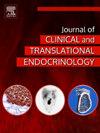Testicular function and fertility outcomes in males with CF: A multi center retrospective study of men with congenital bilateral absence of the vas deferens based on CFTR mutation status
IF 3.3
Q1 ENDOCRINOLOGY & METABOLISM
Journal of Clinical and Translational Endocrinology
Pub Date : 2025-03-27
DOI:10.1016/j.jcte.2025.100388
引用次数: 0
Abstract
Background
Modern cystic fibrosis (CF) treatments, particularly CFTR modulators, have allowed males with CF (MwCF) to live longer, healthier lives and pursue parenthood. Approximately 98% of MwCF have congenital bilateral absence of the vas deferens (CBAVD). While research shows MwCF experience spermatogenic dysfunction alongside obstructive azoospermia, understanding male reproductive health in MwCF remains limited. This study retrospectively examines testicular function and intracytoplasmic sperm injection outcomes of the partners of males with CBAVD, stratified by CF mutation status (CF, CF carriers, no known mutation).
Subjects and Methods
This multicenter, retrospective study assessed sperm retrieval outcomes and testicular function in males with CBAVD. Participants were categorized into three groups: MwCF (Group 1), CFTR gene mutation carriers (CFTR carriers, Group 2), and CBAVD males without CFTR mutations (Group 3). We collected data on genetic testing, testicular hormone levels (FSH, LH, total testosterone), sperm retrieval methods, and reproductive outcomes. Statistical analysis was used to assess intergroup differences.
Results
Thirty subjects were included (Group 1: 14, Group 2: 11, Group 3: 5). No significant differences in demographic, anthropometric, or reproductive characteristics were found across groups. Hormone levels (LH, FSH, and testosterone) were similar among groups. In Group 1, 42 % had elevated FSH levels. The prevalence of hypogonadism was 16.7 % in Group 1. Group 3 had a significantly lower fertilization rate (p < 0.01), but no differences were found in blastocyst formation, pregnancy, miscarriage, or live birth rates.
Conclusions
Our data support the presence of primary spermatogenic dysfunction in some MwCF. However, reproductive outcomes were similar across all groups.
CF男性的睾丸功能和生育结局:基于CFTR突变状态的先天性双侧输精管缺失男性的多中心回顾性研究
背景现代囊性纤维化(CF)治疗方法,尤其是 CFTR 调节剂,让男性囊性纤维化患者(MwCF)活得更长、更健康,并能为人父母。约 98% 的男性囊性纤维化患者患有先天性双侧输精管缺失 (CBAVD)。研究表明,MwCF 在患有梗阻性无精子症的同时还存在生精功能障碍,但对 MwCF 男性生殖健康的了解仍然有限。本研究对CBAVD男性患者伴侣的睾丸功能和卵胞浆内单精子注射结果进行了回顾性研究,并根据CF突变状态(CF、CF携带者、未知突变)进行了分层。参与者分为三组:MwCF(第 1 组)、CFTR 基因突变携带者(CFTR 携带者,第 2 组)和无 CFTR 突变的 CBAVD 男性(第 3 组)。我们收集了有关基因检测、睾丸激素水平(FSH、LH、总睾酮)、取精方法和生殖结果的数据。结果纳入了 30 名受试者(第 1 组:14 人,第 2 组:11 人,第 3 组:5 人)。各组在人口统计学、人体测量和生殖特征方面均无明显差异。各组的激素水平(LH、FSH 和睾酮)相似。第一组中有 42% 的人 FSH 水平升高。第 3 组的受精率显著较低(p < 0.01),但在囊胚形成、妊娠、流产或活产率方面未发现差异。结论:我们的数据证实了部分 MwCF 存在原发性生精功能障碍,但各组的生殖结果相似。
本文章由计算机程序翻译,如有差异,请以英文原文为准。
求助全文
约1分钟内获得全文
求助全文
来源期刊

Journal of Clinical and Translational Endocrinology
ENDOCRINOLOGY & METABOLISM-
CiteScore
6.10
自引率
0.00%
发文量
24
审稿时长
16 weeks
 求助内容:
求助内容: 应助结果提醒方式:
应助结果提醒方式:


